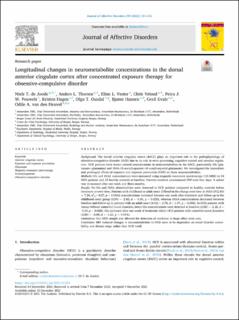| dc.contributor.author | de Joode, Niels T. | |
| dc.contributor.author | Thorsen, Anders Lillevik | |
| dc.contributor.author | Vester, Eline L. | |
| dc.contributor.author | Vriend, Chris | |
| dc.contributor.author | Pouwels, Petra J.W. | |
| dc.contributor.author | Hagen, Kristen | |
| dc.contributor.author | Ousdal, Olga Therese | |
| dc.contributor.author | Hansen, Bjarne Kristian Aaslie | |
| dc.contributor.author | Kvale, Gerd | |
| dc.contributor.author | van den Heuvel, Odile A. | |
| dc.date.accessioned | 2022-03-03T12:56:01Z | |
| dc.date.available | 2022-03-03T12:56:01Z | |
| dc.date.created | 2022-01-12T10:39:57Z | |
| dc.date.issued | 2021 | |
| dc.identifier.issn | 0165-0327 | |
| dc.identifier.uri | https://hdl.handle.net/11250/2982832 | |
| dc.description.abstract | Background
The dorsal anterior cingulate cortex (dACC) plays an important role in the pathophysiology of obsessive-compulsive disorder (OCD) due to its role in error processing, cognitive control and emotion regulation. OCD patients have shown altered concentrations in neurometabolites in the dACC, particularly Glx (glutamate+glutamine) and tNAA (N-acetylaspartate+N-acetyl-aspartyl-glutamate). We investigated the immediate and prolonged effects of exposure and response prevention (ERP) on these neurometabolites.
Methods
Glx and tNAA concentrations were measured using magnetic resonance spectroscopy (1H-MRS) in 24 OCD patients and 23 healthy controls at baseline. Patients received concentrated ERP over four days. A subset was re-scanned after one week and three months.
Results
No Glx and tNAA abnormalities were observed in OCD patients compared to healthy controls before treatment or over time. Patients with childhood or adult onset differed in the change over time in tNAA (F(2,40) = 7.24, ɳ2p= 0.27, p = 0.004): concentrations increased between one week after treatment and follow-up in the childhood onset group (t(39) = -2.43, d = -0.86, p = 0.020), whereas tNAA concentrations decreased between baseline and follow-up in patients with an adult onset (t(42) = 2.78, d = 1.07, p = 0.008). In OCD patients with versus without comorbid mood disorders, lower Glx concentrations were detected at baseline (t(38) = -2.28, d = -1.00, p = 0.028). Glx increased after one week of treatment within OCD patients with comorbid mood disorders (t(30) = -3.09, d = -1.21, p = 0.004).
Limitations
Our OCD sample size allowed the detection of moderate to large effect sizes only.
Conclusion
ERP induced changes in neurometabolites in OCD seem to be dependent on mood disorder comorbidity and disease stage rather than OCD itself. | en_US |
| dc.language.iso | eng | en_US |
| dc.publisher | Elsevier | en_US |
| dc.relation.uri | https://www.sciencedirect.com/science/article/pii/S0165032721013331 | |
| dc.rights | Navngivelse 4.0 Internasjonal | * |
| dc.rights.uri | http://creativecommons.org/licenses/by/4.0/deed.no | * |
| dc.title | Longitudinal changes in neurometabolite concentrations in the dorsal anterior cingulate cortex after concentrated exposure therapy for obsessive-compulsive disorder | en_US |
| dc.type | Journal article | en_US |
| dc.type | Peer reviewed | en_US |
| dc.description.version | publishedVersion | en_US |
| dc.rights.holder | Copyright 2021 The Authors | en_US |
| cristin.ispublished | true | |
| cristin.fulltext | original | |
| cristin.qualitycode | 1 | |
| dc.identifier.doi | 10.1016/j.jad.2021.12.014 | |
| dc.identifier.cristin | 1979158 | |
| dc.source.journal | Journal of Affective Disorders | en_US |
| dc.source.pagenumber | 344-352 | en_US |
| dc.identifier.citation | Journal of Affective Disorders. 2021, 299, 344-352. | en_US |
| dc.source.volume | 299 | en_US |

